Rome is one of the oldest and most beautiful cities in the world – and when being there, you can see why. Full of ancient history, specifically Roman history, Roma, as native Italians call it, is a real treat for a history passionate. However, those who don’t particularly enjoy visiting ancient ruins will find something for themselves as well, which is why the eternal city is a perfect spot for a family vacation.
And with our travel agencies and travel booking websites discount codes, planning a trip to Rome can turn out to be less expensive than some people think.
If you’re planning a trip to Rome soon but aren’t sure how to fill out your days, you couldn’t be in a better place. Here are twenty things to do in Rome that anyone visiting should add to their itinerary.
Table of contents
- 1 1- Travel in Time to the Roman Gladiator Games at the Colosseum
- 2 2- Ride the Breathtaking Roller Coaster at the Rainbow Magic Land
- 3 3- See the Mighty St. Peter’s Basilica
- 4 4- Bathe all day at Hydromania
- 5 5- Walk on Rome’s Oldest Road – Appia Antica
- 6 6- Relax in the Lovely Villa Borghese
- 7 7- Visit the Pantheon – One of the World’s Most Famous Temples
- 8 8- Enjoy Organic and Eco-Friendly Fun at Treja Adventure Park
- 9 9- Experience the Daily Life of Ancient Rome at the Roman Forum
- 10 10- Climb the Spanish Steps
- 11 11- Experience How a Roman Emperor Lived at Hadrian’s Villa
- 12 12- Relax on the Mediterranean Coast at Ostia
- 13 13- Walk Around the Quartiere Coppedè
- 14 14- Walk Around the World’s First Catacombs
- 15 15- Go to the Flea Market at Porta Portese on Sunday
- 16 16- Visit the Beautiful Chiesa di Santa Brigida
- 17 17- Visit the Beautiful Rose Garden Roseto Comunale
- 18 18- Enjoy a Spectacular View from the Janiculum
- 19 19- Take a Magical Bike Ride Through “The Eternal City”
- 20 20- Visit the Castel Sant’Angelo
- 21 VIDEO-Five minutes of Rome
- 22 Additional Things to Consider for Your Rome Trip
- 23 The Bottom Line
1- Travel in Time to the Roman Gladiator Games at the Colosseum
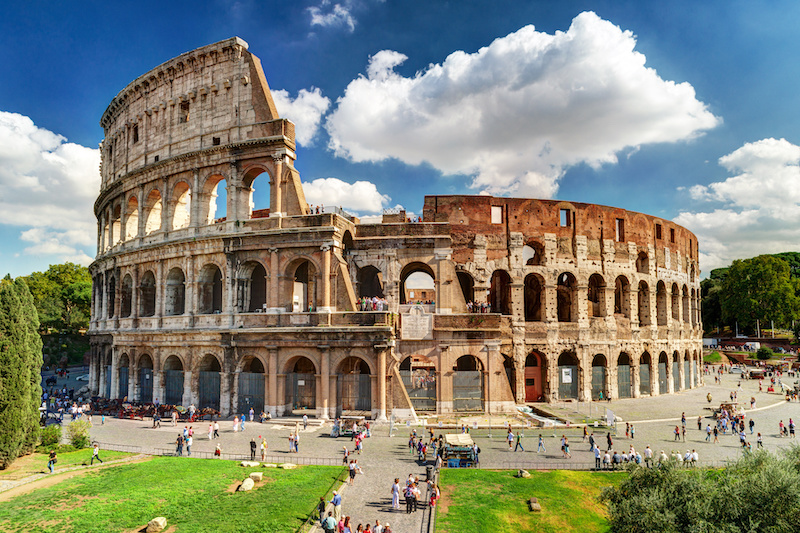
The Colosseum (Colosseo in Italian) is one of Rome’s most famous historical landmarks and most popular tourist attractions. The Colosseum is one of the 50 UNESCO World Heritage Sites in Italy. It was the entertainment centre of the Roman empire – the mighty arena was put into operation in the year 80 AD, and in addition to the famous gladiator games, it was used for theatrical plays, recreating famous battles and conducting public executions.
The Colosseum is very well preserved and when you walk around it is easy to imagine what it must have been like when the arena was filled with 65,000 Romans, eager for entertainment. At that time, there were four floors with the most expensive places for the rich at the bottom, while the lower classes of society were referred to the cheaper seats further up.
Nowadays there is an exhibition that helps visitors see what the arena looked like when it was in use. The possibility of going on a guided tour is available, and alternatively, you can settle for a guidebook and explore the Colosseum at your own pace.
2- Ride the Breathtaking Roller Coaster at the Rainbow Magic Land
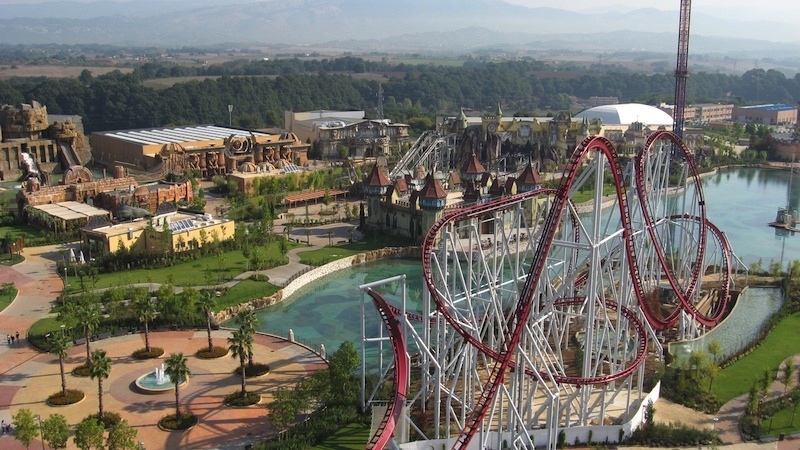
The Rainbow Magic Land is an amusement park located a bit outside the Italian capital – in Valmontone. Although there’s a special bus organised by them going from the city centre, you can also get there using public transport.
The park is full of various rides and activities for all ages. The roller coaster is amazing, but only for the brave. Younger children can visit the cartoon characters from Winx in their fairy castle, and even get an autograph. You can also participate in a sea battle with ten boats that have water cannons.
One day is not enough to see and do everything Rainbow Magic Land has to offer, so you should plan what you want to spend time on. For those who want to spend several days in the amusement park, there are combination tickets that include both an entrance to the park and an overnight stay in a hotel.
3- See the Mighty St. Peter’s Basilica
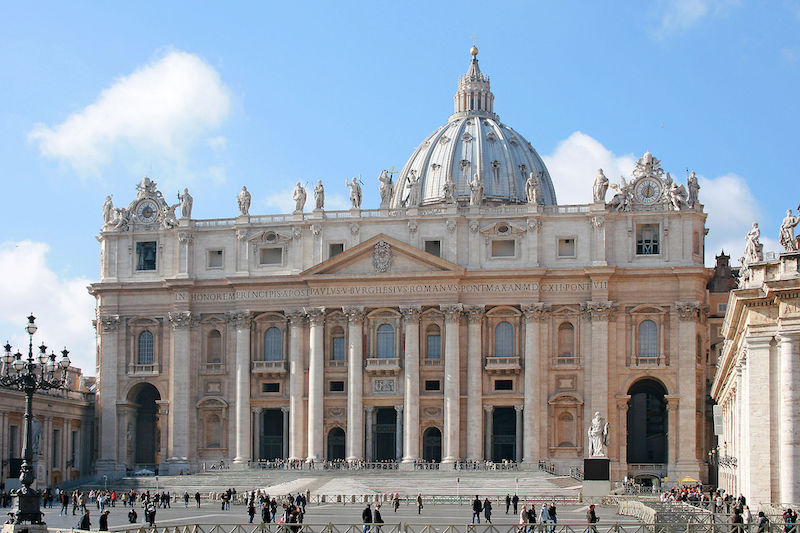
The St. Peter’s Basilica (Basilica di San Pietro in Italian) is one of the main attractions of Rome and the largest building in Vatican City. Located next to St. Peter’s Square (Piazza San Pietro), it is one of the most important locations for the catholic church, as Peter – Jesus’ Apostle and the first Pope – is buried there. When visiting St. Peter’s Basilica, you can also take the stairs up the church tower and enjoy a fantastic view of Rome.
Just keep in mind that since it is a church, there is a dress code – you most likely won’t be able to enter with bare shoulders and/or shorts. Although the line can get long due to a necessary security check before entering one of the most famous religious buildings in the world, it usually goes pretty quickly. The church is estimated to hold up to 60,000 visitors.
What’s more, Basilica di San Pietro contains large amounts of paintings and statues by Italian masters such as Bernini and Michelangelo (including the world-renowned Pietà sculpture). And if you’re an art enthusiast, the Vatican Museums, which house for example the Sistine Chapel, are located a walking distance from St. Peter’s Square. They are especially worth visiting during the last Sunday of the month, as the entrance is free then.
4- Bathe all day at Hydromania
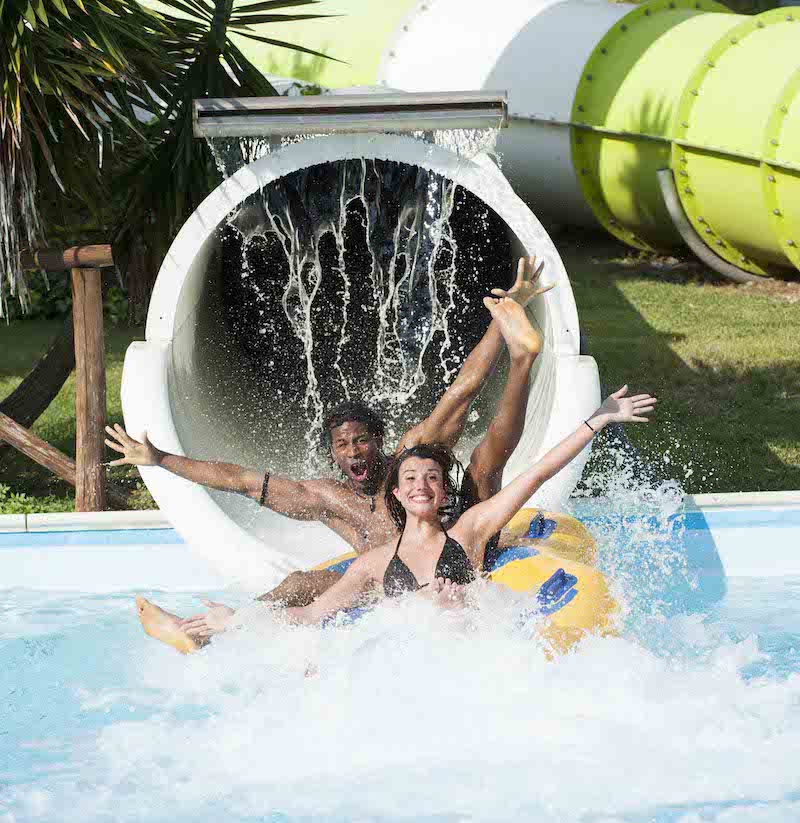
Hydromania is a very large water park located close to Rome. You can take their bus that runs from Piazza della Repubblica or you can take the metro and bus. Children shorter than 1 meter do not pay entry, and you can also choose the half-day price. The park is full of pools and water slides of different sizes. During the holiday season, the lines for the slides can be quite long, especially on weekends. At the entrance, there are lockers for keeping your valuables safe. Around the area, there are small restaurants or kiosks where you can eat. You can book a package for a hotel and park in one, but most choose to visit Hydromania only for the day.
5- Walk on Rome’s Oldest Road – Appia Antica
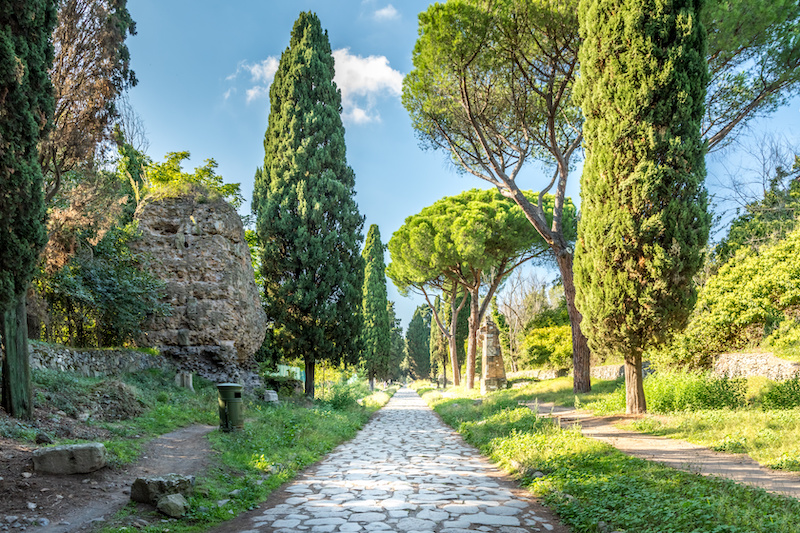
Appian Way Regional Park is a large, protected park of 4,580 hectares. Part of the park consists of the ancient road Appian Way (Via Appia Antica in Italian), which is over 2,000 years old. Many notable historical events took place along this road, such as the crucifixion of Spartacus’ army or the battle of Anzio during World War II.
You can easily get here by public transport, as there is a bus from the Piramide or Colle Albani metro stations. The best day to visit Via Appia Antica is a Sunday, as the road is off-limits for car traffic, but you can still walk or ride a bike.
You can also visit various museums and churches that are located on the territory of the Appian Way Regional Park. One of the most famous is the Church of St. Sebastiano and its ancient catacombs, as well as funerary monuments that can be found along the road.
Are you looking for a nice hotel to stay at while visiting Rome? To get the best price you should check out our page with Expedia voucher codes and deals.
6- Relax in the Lovely Villa Borghese
Villa Borghese is a beautiful old park located almost in the middle of Rome. You can easily get there by public transport. Inside the area, you can walk, rent bikes and Segways, rent a rowing boat or simply sit and enjoy the surroundings. The large pine trees provide shade, something you might need during the hot Italian summer. This is a place where the Romans themselves come to take a break from traffic jams and stress. Despite this, it never feels full, as the park is so large that there is plenty of room to find a quiet place.
However, the park is not the attraction – there’s also an art gallery, the Borghese Gallery (or Galleria Borghese in Italian). Located inside a beautiful 17th-century villa, aside from being one of the most famous art galleries in Rome, it is also probably the most stunning one. Among the art pieces that you can find there, are, for example, David with the Head of Goliath by Caravaggio or The Deposition by Raphael. It’s certainly worth placing it on your list of things to do in Rome!
7- Visit the Pantheon – One of the World’s Most Famous Temples
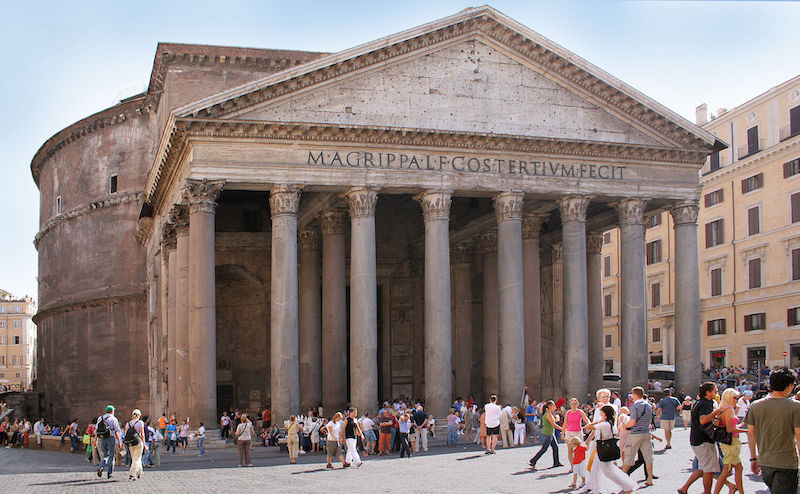
The Pantheon, a former temple of the Roman gods located on Piazza della Rotonda, is a must when it comes to Rome attractions. Built almost 2,000 years ago, it was initially a small temple dedicated to all the gods of Roman mythology. However, like many other old buildings, it has been renovated and rebuilt several times, mainly by Emperor Hadrian in the second century AD (around 126 AD.)
It has been said that the Pantheon was drawn by angels, not men because it is considered too beautiful to be built by mortals. The immense dome is very impressive, it is the largest masonry dome in the world. This is very impressive given how old it is. The Pantheon is also one of the world’s best-preserved monuments. The reason the Pantheon is so well preserved is that it has always been in use, although in the 6th century, it was converted from a Roman temple to a Catholic Church. Funerary monuments of a few Italian kings, as well as Raphael, are located inside it.
What’s more, Pantheon is located very close to the Trevi Fountain (Fontana di Trevi) and Piazza di Trevi – it’s only about a seven-minute walk. Just keep in mind since both Pantheon and Trevi Fountain are some of the most commonly visited Rome attractions, there might be a lot of people, especially during the summer.
8- Enjoy Organic and Eco-Friendly Fun at Treja Adventure Park

The Treja Adventure Park is the largest in Lazio. What’s more, it is completely eco-friendly, so it could be another great suggestion for your list of things to do in Rome. You don’t do anything that destroys nature, even though you do climb both up and down the trees. There are trails and activities for all ages so that the whole family can have an amazing, active day. The park is a fun alternative to traditional amusement parks for those who like outdoor activities.
During the summer holidays (June 6 to September 7), the park is open every day, otherwise only on Saturdays and Sundays. From December to February, the park is closed. It costs nothing to enter the park, and you can eat your packed lunch. Keep in mind that you’ll have to pay separately for the activities. To get here from central Rome, you should preferably have a car, but you can also take a bus.
9- Experience the Daily Life of Ancient Rome at the Roman Forum
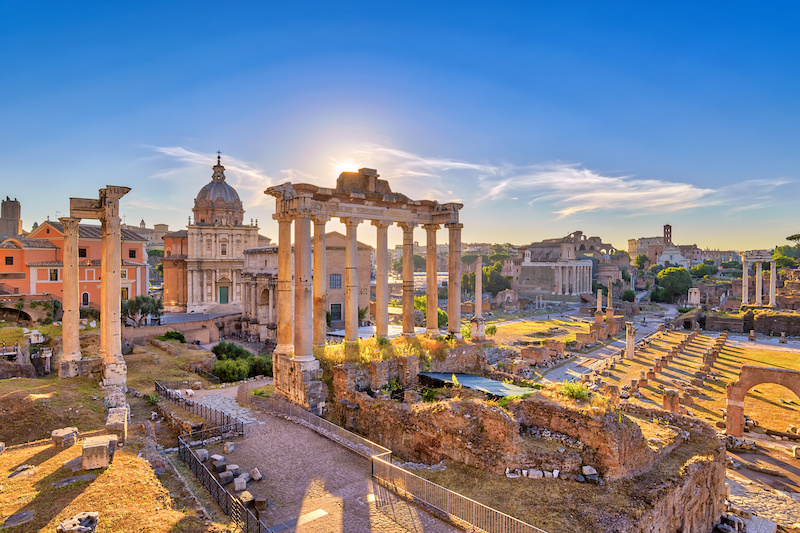
The Roman Forum, or Forum Romanum, is located in the historic centre, right next to the Colosseum. Usually, the same ticket can be used for both iconic landmarks. This is a huge excavation of ancient Rome, the market square and the public space of Rome – it was here that the main buildings were located, such as the royal palace and the temple of Vesta.
What’s more, it is said that Palatine Hill (Palatino) which is located in the same area as the Roman Forum, was the place where Romulus founded the city in 753 BC, so if you want to go back to the beginning of the eternal city, this one of the Seven Hills is the perfect place to start.
Many ruins have been identified, and a great deal has been preserved. The Roman Forum gives an insight into what the day-to-day life of ancient Rome looked like in a way that other monuments cannot.
It is important to either take advantage of guided tours or have a good guidebook with you, as there’s plenty to see and you can miss out on many things if you don’t know what exactly you’re looking at. Although there are also other forums or marketplaces around, Forum Romanum is the largest. You can see a replica of what the Forum looked like once upon a time in the Forum Museum.
It’s also worth mentioning that the Roman Forum is located close to the Victor Emmanuel II National Monument (Monumento a Vittorio Emanuele II in Italian), which has a terrace with a beautiful view of the whole city. The monument was built to honour Victor Emmanuel II – the first king of unified Italy.
10- Climb the Spanish Steps
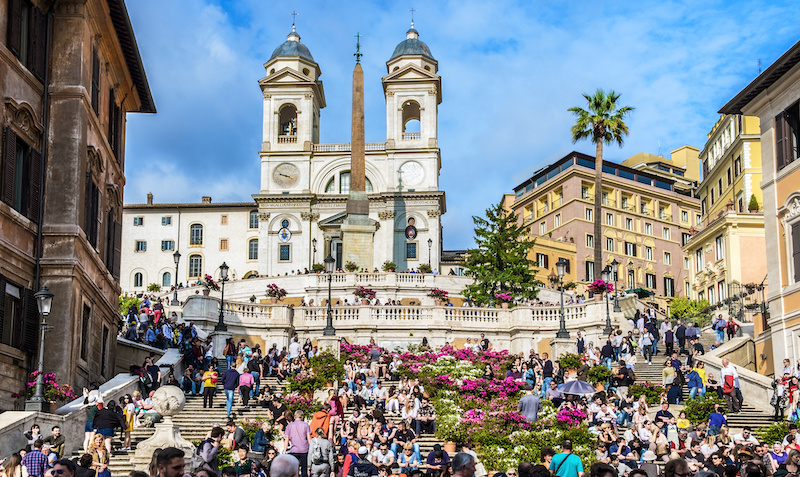
The Spanish Steps, in Italian, called La Scalinata di Trinità dei Monti, are a major tourist attraction, but even the Romans themselves like to come here. Like the Trevi Fountain, the most famous fountain in Rome, the Spanish Steps have been featured in many films and literary works.
The long staircase ends in a square where there is a fountain. The staircase is not Spanish – it was the French king who donated money to it when it was built in the 18th century. The Square at the base of the stairs is called Piazza Di Spagna, and that’s most likely where the name comes from. The stairs themselves are very wide and have 135 steps.
Both at the top and around the base are nice cafes and restaurants, although prices are quite high in this area. Otherwise, you just sit on a bench and people-watch. Just keep in mind that sitting on the actual steps is prohibited. All around there are several exclusive stores with several famous brands.
11- Experience How a Roman Emperor Lived at Hadrian’s Villa
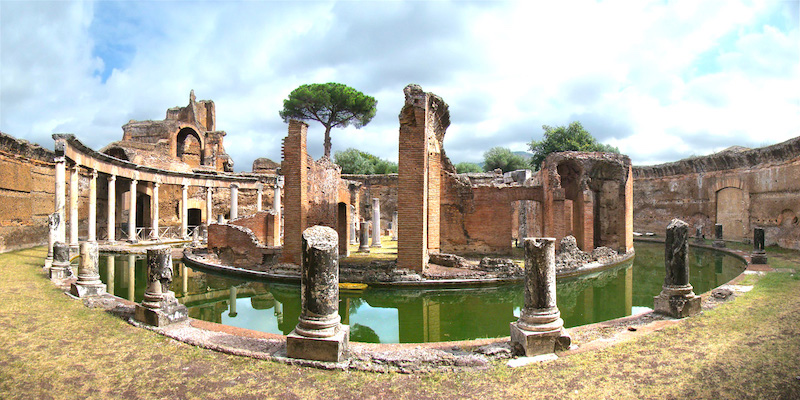
Hadrian’s Villa (Villa Adriana) is located in Tivoli, on the outskirts of Rome. It’s a large archaeological excavation that is very interesting to visit. When it was built, around 180 AD, it served as a summer palace for Emperor Hadrian. But Hadrian liked it so well that he spent more and more of his time here and eventually reigned from the palace. The area is large, about a square kilometre and includes buildings such as palaces, a theatre, libraries and much more.
While not all parts have been excavated, you can still see plenty. The palace is amazing – it is said to be an architectural masterpiece. Lots of art and other objects have also been excavated – these items are shown in, among other places, the Vatican Museums. Hadrian’s villa provides a good insight into the luxury and opulence of a Roman emperor.
12- Relax on the Mediterranean Coast at Ostia
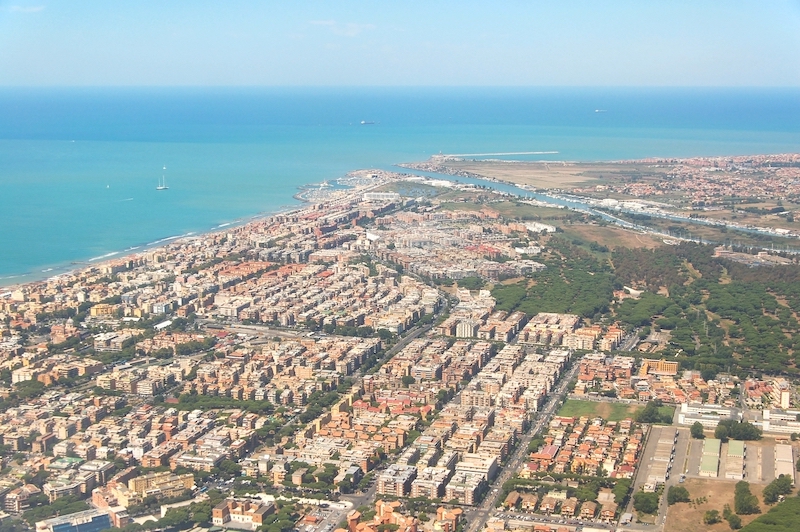
Ostia officially belongs to Rome but is a small town right next to the Mediterranean Sea, where you can find several kilometres of lovely sandy beaches where you can swim and relax. Part of the beach is completely free of charge; these public beaches are called Cancello. There are showers, toilets and changing rooms, as well as several places to eat and kiosks. There is clean drinking water in a tap, and you can rent sun loungers and beach umbrellas if you wish. Although there are many visitors during the summer days, there is plenty of room because the beaches are so long.
A little closer to the city itself there are several establishments with private beaches, one by one in a long line. Here you must pay to get access to the beach, but in return, you can enjoy better facilities. It is often cleaner here since it’s private.
13- Walk Around the Quartiere Coppedè
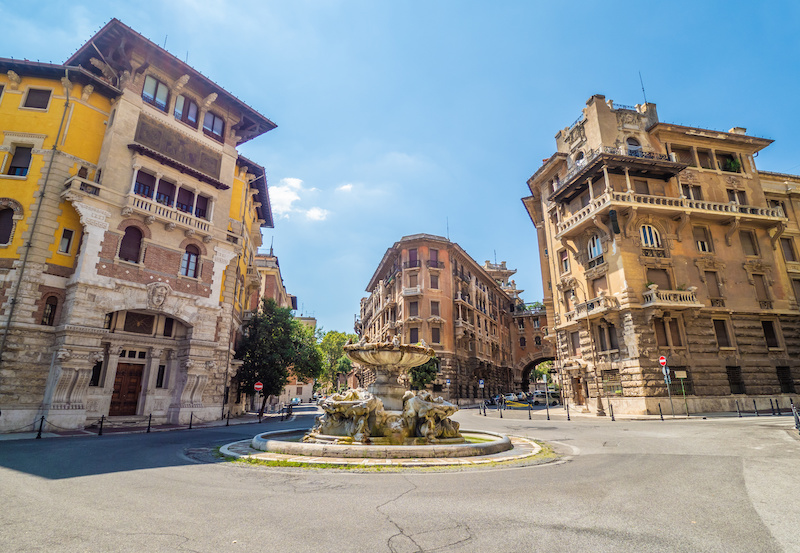
For those who are looking for one of the less frequented tourist attractions, it is worth making your way to Trieste in the northern part of Rome and visiting the quartiere Coppedè. This neighbourhood of 31,000 sqm was designed by the eccentric architect Coppedè for ten years up until he died in 1927.
The architecture of Coppedè is usually included in the style of art nouveau. You can find a fascinating mix of styles from different periods in time – influences from antiquity and the Middle Ages share space with more modern styles in a way that creates a unique kind of atmosphere. Due to its unique design, Quartiere Coppedè has appeared in several films. It’s a one-of-a-kind experience to walk around here and visiting the neighbourhood is free.
14- Walk Around the World’s First Catacombs
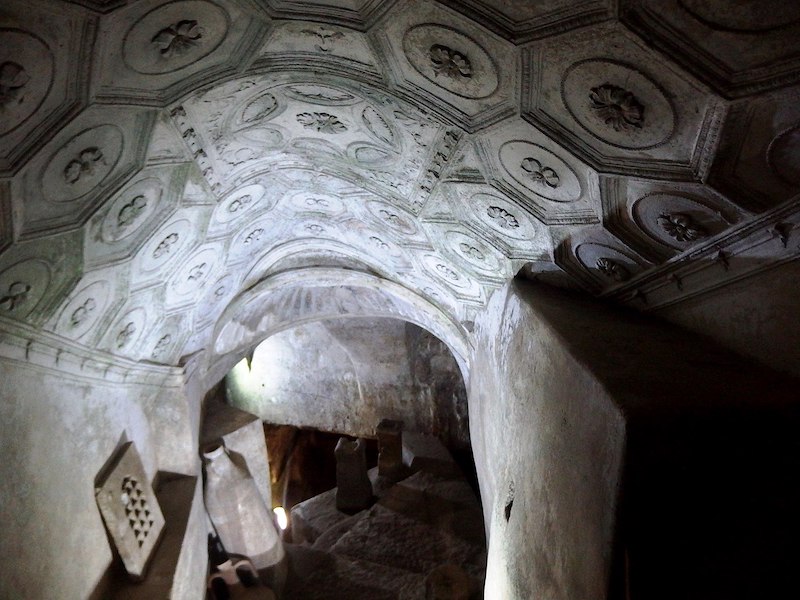
Along the Via Appia Antica, you will find the catacombs of San Sebastiano (Catacombe di San Sebastiano), where St. Sebastian is said to be buried. Since the 5th century AD, catacombs have been used for funerals. This was where the word “catacombs” was first used to describe Christian burial chambers.
The Basilica holds several holy catholic relics, including the arrow that is said to have killed St. Sebastian or marble footsteps that are believed to have belonged to Jesus from his walk along Via Appia Antica on his way to Rome. Even if you are not a Christian yourself, these catacombs are a moving place to visit and one can easily combine a visit to the catacombs with exploring the rest of the park around Via Appia Antica.
15- Go to the Flea Market at Porta Portese on Sunday
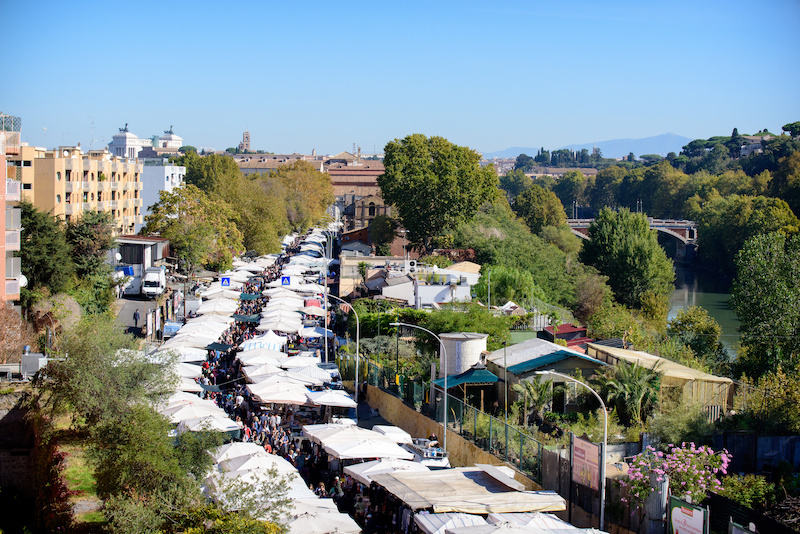
If you have time left over on Sunday in Rome and like bargaining, the flea market at Porta Portese is well worth a visit. The market is only open on Sundays and is close to two kilometres long. There are several restaurants and coffee shops to sit down and rest while trying some of the best ice cream in the world in case you need to take a break. At the market, you can find a lot of cheap stuff. There are a lot of souvenirs and mass-produced gadgets but the closer to the Trastevere centre you get, the more unique and interesting stands you will find. Here you will find clothes, old comic books, toys and many interesting gadgets. Most of it usually goes for 1-2 euros.
16- Visit the Beautiful Chiesa di Santa Brigida
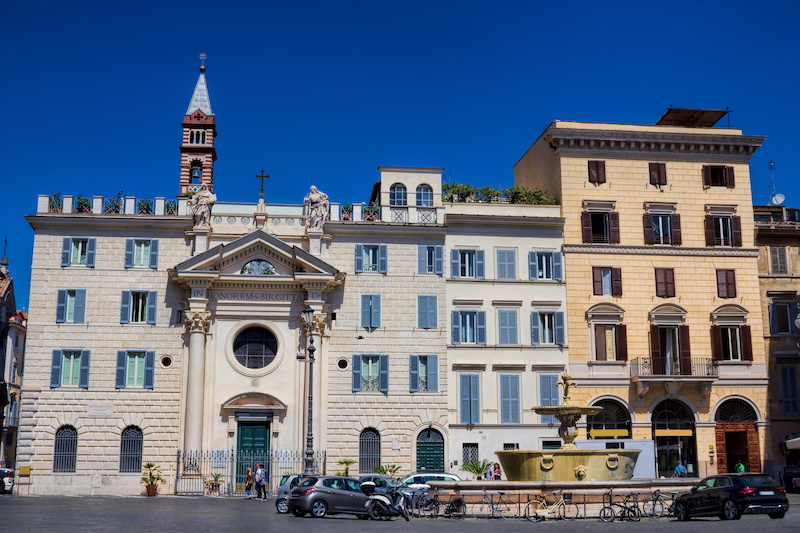
Chiesa di Santa Brigida is a grand building in downtown Rome, where Saint Bridget lived from 1353 until she died in 1373. Today, this medieval palace is partly a convent and partly a hotel run by the nuns themselves. The top floor, where Bridget lived and studied, houses the St. Bridget Museum and a small chapel.
Chiesa di Santa Brigida is at Piazza Farnese in the historic district (Centro Storico). One night in a double room costs about €200, so a one-day visit to the museum is usually enough for most visitors.
17- Visit the Beautiful Rose Garden Roseto Comunale
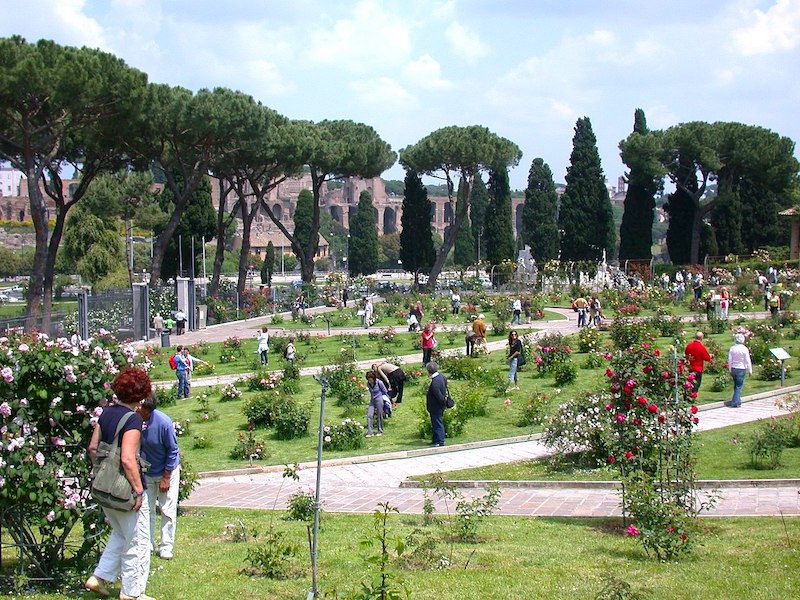
Next to Circo Massimo, at the foot of the Palatine Hill, you will find one of the most romantic gardens in all of Rome – Il Rosetto Comunale di Roma. Here you can see close to 1100 different species of roses. The garden is only open during spring when the roses bloom and the garden is filled with lovely scents. Admission is free both for locals and tourists.
The gates to the garden are opened on April 21 (the birthday of the city of Rome) and stay open until mid-June. It is a very quiet rose garden, although it is just a short distance from the lively traffic around Circus Maximus.
18- Enjoy a Spectacular View from the Janiculum
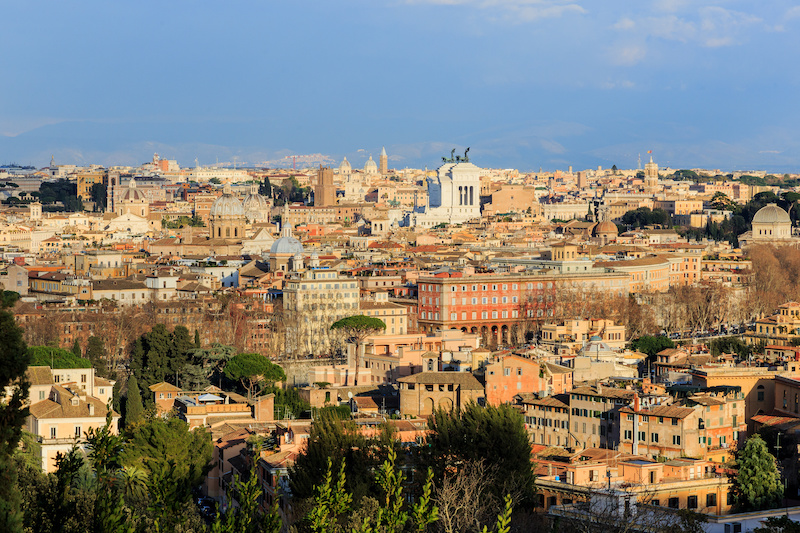
The Janiculum (Gianicolo in Italian) is a hill west of the picturesque Trastevere district. From the top of the hill, you have a stunning view of the city’s ruins, monuments, towers and domes. A walk along the Janiculum is a must when you visit Rome. Families with children usually go up here on Sundays as you can see a traditional puppet theatre performance that both children and adults enjoy.
At the Janiculum, you can also visit the monastery of San Pietro in Montorio – a beautiful Renaissance church built for Peter the Apostle, and Fontana dell’aqua Paola, a magnificent fountain erected by Pope Paul V in the late 16th century.
19- Take a Magical Bike Ride Through “The Eternal City”
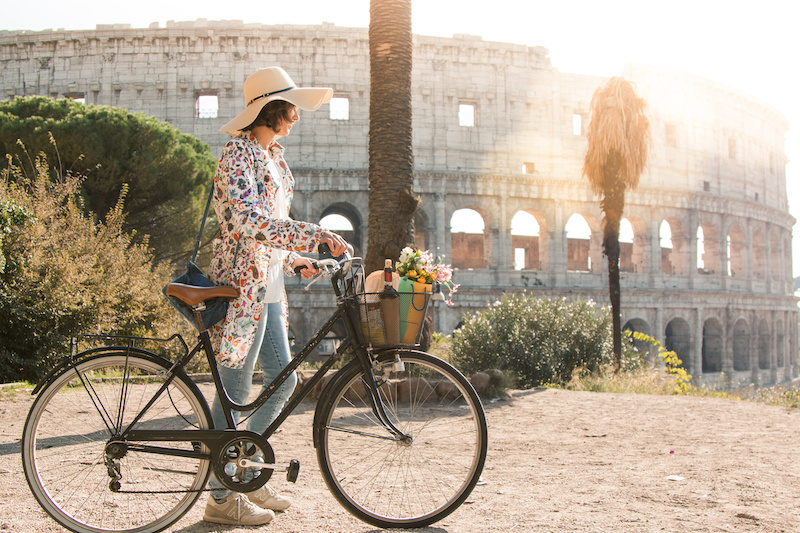
If you don’t feel compelled to rent a Vespa in chaotic Rome, a regular bike is a perfect way to discover this magical city. Head out into the city on your own or book a three-hour sightseeing tour through Rome’s historic core. Bike along the beautiful coast of the Tiber River, view the ruins and the monuments, peddle around the Colosseum and the Roman Forum, past the cobbled squares and the winding streets of the Jewish ghetto, and explore the city’s most emblematic districts, such as Trastevere and the Vatican.
Rome has 3,000 years of existence, so you will surely get to learn a lot about its amazing history, and at the same time burn a few calories.
20- Visit the Castel Sant’Angelo

Castel Sant’Angelo (Castle of the Holy Angel) which was originally intended to be a mausoleum of the Roman emperor Hadrian, was built in 139 AD. However, since then, it has changed its purpose a few times – it was a fortress, prison, and Pope’s residence, and today the building is used as a museum.
The name Castel Sant’Angelo was first been used in 590, when Pope Gregory I had a vision of Archangel Michael sheathing his sword on top of the castle during a pandemic, signalling its end. A few centuries later, Pope Pius II built a chapel where the archangel was said to have appeared. However, the large bronze statue that can be seen from the bridge leading to the castle was placed there quite late, in the XVIII century.
The area around it is often used by street performers, playing and singing songs, which ensures that the visit to the museum is an experience that you won’t forget. And if you don’t mind a bit of a workout, make sure to climb the stairs to the top of the castle, where you can find a terrace – it will give an amazing view of Rome, in particular St Peter’s Square.
VIDEO-Five minutes of Rome
Additional Things to Consider for Your Rome Trip
Walkability:
- Rome boasts a compact historic centre, perfect for exploring on foot. Most major attractions are within walking distance, allowing you to soak in the city’s vibrant atmosphere firsthand. Comfortable shoes are a must!
- Consider walking tours led by locals who can share hidden gems and insights beyond guidebooks.
Scams:
Unfortunately, tourists in Rome can be targets for scams. Be mindful of:
- Overpriced street food or drinks, especially around major attractions.
- “Fake guides” offering unofficial tours.
- Pickpockets in crowded areas.
- Sudden “accidents” involving spilt liquids or bumping into objects, followed by demands for cleaning fees.
Seasonal Considerations:
- Spring (March-May): Pleasant weather, fewer crowds, beautiful blooming flowers.
- Summer (June-August): Hot and crowded, but vibrant atmosphere and extended daylight hours. Consider early mornings or evenings for outdoor activities.
- Autumn (September-November): Mild weather, comfortable sightseeing, and harvest season offers fresh local produce.
- Winter (December-February): Cooler temperatures, potential for rain, fewer crowds, and lower prices. Christmas markets and festive decorations add to the charm.
Bonus Tips:
- Learn basic Italian phrases for politeness and navigating interactions.
- Invest in a good travel guide and map, or download offline maps and translation apps.
- Pack light and adaptable clothing for different weather conditions.
- Don’t forget sunscreen and a hat during sunny days.
- Sample local cuisine and indulge in the city’s rich culinary tradition.
- Relax and enjoy the pace of life, soak in the history, and appreciate the unique charm of Rome!
These are just some additional points to consider, and the perfect trip to Rome looks different for everyone.
The Bottom Line
Rome has so much to offer that it’s impossible to compile everything into one list – Piazza Navona, Piazza del Campidoglio, Pincio Hill, Aventine Hill or Basilica di Santa Maria Maggiore with the largest shrine in Rome dedicated to the Virgin Mary are just a few things that deserve mention when talking about this city.
What’s more, we often have discount codes for sites like Viator so that when you want to experience something more modern than the ancient ruins, you have plenty of unique experiences to choose from.
Truthfully, no matter in what part of Rome you are, you are bound to find something to see closely. It’s a city that you simply cannot get bored of, as every day you can discover something new – the list of things to do in Rome could go on and on. Bon Voyage! Or should we say Buon Viaggio?
References:
- https://www.tripadvisor.com/Attractions-g187791-Activities-Rome_Lazio.html
- https://travel.usnews.com/Rome_Italy/Things_To_Do/
- https://www.thediscoveriesof.com/best-things-to-do-in-rome/
- https://www.cntraveler.com/gallery/best-things-to-do-in-rome
- https://www.timeout.com/rome/things-to-do/best-things-to-do-in-rome
- https://theromanguy.com/italy-travel-blog/italy-travel-blog/rome/top-things-to-do-in-rome-for-this-year/
- https://www.timeout.com/rome/things-to-do/best-things-to-do-in-rome
- https://www.placesofjuma.com/best-things-to-do-in-rome/
- https://romesite.com/attractions.html
- https://www.viator.com/Rome/d511
- https://tourscanner.com/blog/things-to-do-in-rome/
- https://notaboutthemiles.com/best-things-to-do-rome/
- https://nomadsunveiled.com/best-things-to-do-rome/
- https://www.thecrazytourist.com/25-best-things-rome-italy/
- https://expertvagabond.com/rome-things-to-do/

Hello! I am Axel, tripplo.com’s travel savings, deals and discounts expert and founder. I have been in the travel deals and discounts industry for almost a decade now. It’s me who publish and update most of the content and discounts on tripplo.com! I also have a podcast in which I share valuable information about how to get the best travel deals and discounts.









